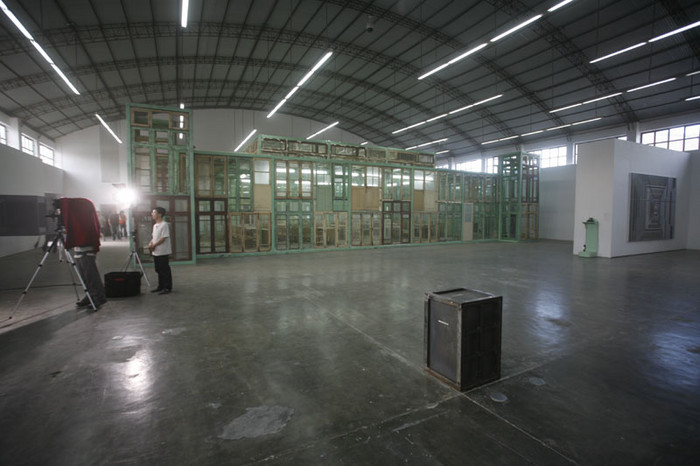The Outcast
20 May - 23 Jun 2007
THE OUTCAST
UniversalStudios-Beijing,
2007.05.20 —— 2007.06.23
Tuesdays to Sundays
11:00-18:00
The word outcast has many connotations, ranging from someone who has been rejected from society to a homeless vagabond and a wanderer; it also extends to rejected matter and cultural refuse. Liu Wei examines all of these meanings in his new solo exhibition, which features two new installation works as well as paintings from his ‘Purple Air’ series.
Large scale canvases (averaging 300 x 190cm) the five works from the ‘Purple Air’ series examine Beijing’s modern skyline. With their layered, overlapping strands of colour and almost geometric patterns, the works themselves recall the exposed circuitry and intricate pathways of microchips and computer motherboards. Yet in some places the lines quiver and paint drips down the canvases as if the structure of the buildings themselves and the reality they represent is slowly disintegrating. At the centre of many of these works the glazed rings of an oblique sun are caught between the dark outlines of skyscrapers, casting out nuclear halos of gradated light. In these works Liu Wei’s depiction of the modern metropolis is permeated by dark undercurrents of urban decay and an almost Blade Runneresque vision of the future.
At the centre of the space is the artist’s new installation work, after which the exhibition takes its name. ‘The Outcast’ features a strip of barren land in which bleached grass, broken rubble and discarded rubbish are enclosed within 3m high glass walls. The transparent walls immediately objectify the space within and transform it from being a bleak urban wasteland to a metaphor for the disposable and visceral nature of contemporary urban society. Like the plastic bags and other urban detritus that continuously drifts within the enclosed walls, Liu Wei makes a wry social commentary on the nature of modern alienation and social anomie.
The second installation follows a similar concept but uses dark, smoked glass to create the impression of a nocturnal scene. Through the glass the viewer is able to glimpse the bisected roof of a house and the upper section of severed electrical pylons. Seen from this perspective the viewer appears to be floating above the scene, resulting in an effect which is simultaneously unnerving, voyeuristic and eerie.
While Liu Wei’s installation and paintings often reflect a sentiment of cultural decay and erosion, the artist is unique in that his work displays a direct reaction to his environment and surroundings rather than the more reflective approach adopted by other contemporary artists. Through his art he engages directly with contemporary society and seeks to force the viewer to do the same.
UniversalStudios-Beijing,
2007.05.20 —— 2007.06.23
Tuesdays to Sundays
11:00-18:00
The word outcast has many connotations, ranging from someone who has been rejected from society to a homeless vagabond and a wanderer; it also extends to rejected matter and cultural refuse. Liu Wei examines all of these meanings in his new solo exhibition, which features two new installation works as well as paintings from his ‘Purple Air’ series.
Large scale canvases (averaging 300 x 190cm) the five works from the ‘Purple Air’ series examine Beijing’s modern skyline. With their layered, overlapping strands of colour and almost geometric patterns, the works themselves recall the exposed circuitry and intricate pathways of microchips and computer motherboards. Yet in some places the lines quiver and paint drips down the canvases as if the structure of the buildings themselves and the reality they represent is slowly disintegrating. At the centre of many of these works the glazed rings of an oblique sun are caught between the dark outlines of skyscrapers, casting out nuclear halos of gradated light. In these works Liu Wei’s depiction of the modern metropolis is permeated by dark undercurrents of urban decay and an almost Blade Runneresque vision of the future.
At the centre of the space is the artist’s new installation work, after which the exhibition takes its name. ‘The Outcast’ features a strip of barren land in which bleached grass, broken rubble and discarded rubbish are enclosed within 3m high glass walls. The transparent walls immediately objectify the space within and transform it from being a bleak urban wasteland to a metaphor for the disposable and visceral nature of contemporary urban society. Like the plastic bags and other urban detritus that continuously drifts within the enclosed walls, Liu Wei makes a wry social commentary on the nature of modern alienation and social anomie.
The second installation follows a similar concept but uses dark, smoked glass to create the impression of a nocturnal scene. Through the glass the viewer is able to glimpse the bisected roof of a house and the upper section of severed electrical pylons. Seen from this perspective the viewer appears to be floating above the scene, resulting in an effect which is simultaneously unnerving, voyeuristic and eerie.
While Liu Wei’s installation and paintings often reflect a sentiment of cultural decay and erosion, the artist is unique in that his work displays a direct reaction to his environment and surroundings rather than the more reflective approach adopted by other contemporary artists. Through his art he engages directly with contemporary society and seeks to force the viewer to do the same.

